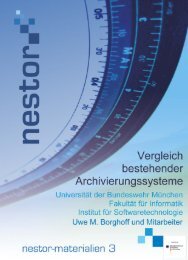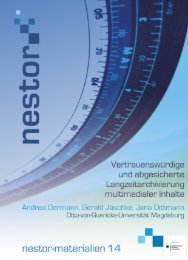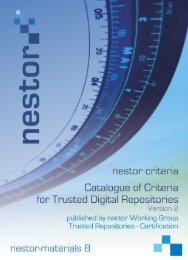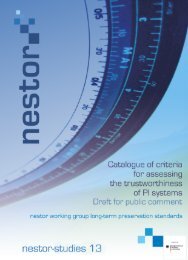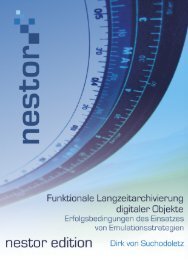Download (PDF, 9MB, Not barrier-free file.) - Nestor
Download (PDF, 9MB, Not barrier-free file.) - Nestor
Download (PDF, 9MB, Not barrier-free file.) - Nestor
- No tags were found...
You also want an ePaper? Increase the reach of your titles
YUMPU automatically turns print PDFs into web optimized ePapers that Google loves.
It seems that of all three repositories, Qucosa is in the most difficult position when itcomes to defining and monitoring its designated communities. Thus, as explained above,the latter are of a highly heterogeneous nature including among others researchers,scholars, and students of Saxon universities, as well as depositors/users from vocationalcolleges, the business sector and from public administration. It seems that especiallydocuments published by public administration will be of interest to a “wider public,” makingit particularly difficult to define – let along monitor – their designated user communityprecisely. It follows that a close and detailed monitoring of all communities that might havean interest in the publications provided through Qucosa is impossible to accomplish withlimited financial and human resources. While this does not mean that the SLUB Dresdenshould refrain from any monitoring activity, a workable solution has to be found – e.g. bylimitation to few “model communities.” Thus faculty and students of the TU Dresden(possibly limited to the disciplines most strongly represented in the repository) might serveas such a model community. In addition, a routine could be established in which otherinstitutions whose members submit publications to Qucosa or existing advisory councilsmonitor their communities and notify Qucosa should significant changes occur.Similarly as in the case of the other two repositories, surveys should be carried outamong users and producers in the future to gather information about the technology theyuse, for example, or about the usability of Qucosa from their perspective (e.g., theunderstandability of the metadata).In that Qucosa is managed by department for information technology of the SLUBDresden, technological developments are closely monitored by the staff who will reactshould significant changes, e.g. in hardware or software technology, occur. However, nodocumented policies exist for this monitoring activity.2.7 Common Services and RequirementsIn addition to the functional entities described and explained above, the OAIS modeldefines a set of (strongly IT-centered) common services meant to support the operation ofthe long term digital archive, for example by providing security services “to protectsensitive information and treatments in the information system” (OAIS 2002, 4-4).Similarly, the criteria catalogs introduced above contain a number of criteria whichconcern the entire repository rather than a single functional entity or sub-entity, addressingthe necessary IT-infrastructure, quality management as well as the overall organization ofthe long-term archive (see Appendix A).Thus, nestor criterion 4 requires the long-term archive to be organized in a mannerallowing it to fulfill the goals it set itself, pointing to adequate and financial and humanresources among others (see nestor 2008, 4.1 and 4.2). While currently all threerepositories seem adequately equipped with staff and resources (although, clearly, thequestion of adequacy in this context is one of “those 'would you like more money?'73



